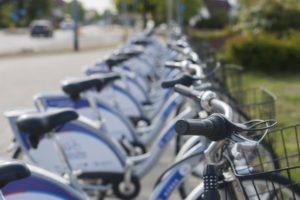NEW CYCLING GUIDANCE FOR LOCAL AUTHORITIES
NEW GUIDANCE BRINGS TOGETHER INFORMATION AND GOOD PRACTICES FROM AROUND EUROPE
Cycling is one of the cleanest, healthiest and most efficient forms of transport. Recently new guidance has been published online, which brings together national and local guidelines, as well as case studies, from around Europe. The guidance was produced for the European Commission (DG MOVE) by a consortium involving TEPR and FGM-AMOR, which was led by Ricardo Energy & Environment.
The idea behind the development of the guidance is to encourage the implementation of measures to promote cycling in cities and towns across Europe whatever their current level of cycling. Rather than replicate existing guidelines, the new guidance brings together existing guidelines in one place to enable those interested to access these easily. It also contains summaries of a range of cycling measures, drawing on existing guidelines and the 20 case studies that were undertaken for the project, as well as links to other national and local guidelines and other collections of good practices.
The benefits and evolution of cycling
Cycling is good for both individuals and the environment. In order to deliver its health and environmental benefits, it is important that cycling is seen as a mode of transport in its own right, rather than simply a recreational activity. The bicycle has been around for much longer than the motor car – Frenchman De Sivrac built the first bicycle-type vehicle in 1690. Since then the bicycle has evolved to the advanced pedal-powered, and increasingly electrically-assisted, vehicle that we have today. It will play an important role in the future, low carbon and healthy city.
Cycling is good for health and the environment
There are multiple health benefits from cycling. It is a low impact anaerobic activity, which is suitable for people of all ages. With the increase in the availability of electrically-assisted bicycles (also known simply as ‘electric bikes’ or ‘e-bikes’), the age range in which people can actively cycle will increase further. Regular cycling can lead to increased cardiovascular fitness, increased muscle strength and improved flexibility. Other benefits include improved mental well-being and reduced anxiety and stress. These benefits outweigh any negative impacts from cycling in a polluted city in Europe. Cycling is also relatively inexpensive compared to other modes of transport.
If people switch from motorised travel to cycling, their journeys will be less polluting and quieter. Hence, if there is a significant switch to cycling, urban air will be cleaner, which will have benefits for human health and urban buildings, and cities will be quieter. The economic costs of traffic delays will also be reduced as a result of there being less congestion. Increased levels of cycling also contribute to a safer road environment, as traffic will be slower and less dangerous as a consequence.
Cycling as an efficient mode of transport
Increasing levels of cycling will not just have benefits for health and the environment: cycling also uses the limited – and expensive – urban space much more efficiently than many other modes of transport. For cities looking at how to move a large number of people around as efficiently as possible, it will be important to consider how to increase levels of cycling. Cycling is also much more efficient in terms of the use of space for parking: 10 bicycles can be parked in the same space that is needed for a single car.
How do cities compare?
Currently, there are some stand-out cities for cycling within Europe. The Danish capital Copenhagen is an excellent example, with years of pro-cycling policies delivering a city that is built for cyclists and that has more bicycles than cars in the city centre. Amsterdam is another European city that is famous for cycling. High levels of cycling can be found in many Dutch cities, while there are cities in other countries – Strasbourg in France, Cambridge in the UK – which stand out for their high levels of cycling. The fact that these cities stand out underlines the relatively low levels of cycling that exist elsewhere.
The new guidance
The guidance aims to support cities that have different levels of cycling: from those that are just starting to introduce measures to develop cycling to those that are aiming to increase cycling to the levels of Copenhagen and Amsterdam. It can be found on the European Commission’s website. The guidance supplements the SUMP Guidance on cycling, which was published in October 2019.
TEPR and its work on cycling
TEPR is an independent research consultancy that works on projects to improve active mobility, including cycling. For the study, TEPR developed a number of pages of the guidance as well as developing the case studies for the Danish capital Copenhagen, Brussels (Belgium), the French city of La Rochelle and Brighton in the UK. For more details about the project in general, or the case studies in particular, contact Ian Skinner at TEPR (ian.skinner@tepr.co.uk) or call +44 (0)7521 063324.
Picture credit: pixabay


Leave a Reply
Want to join the discussion?Feel free to contribute!